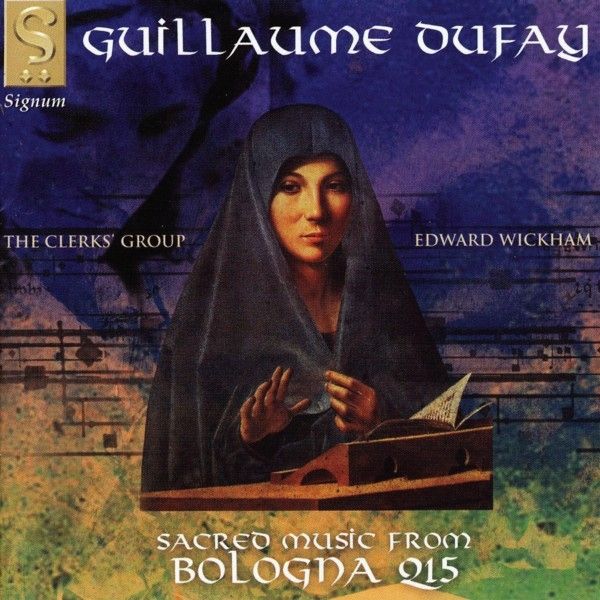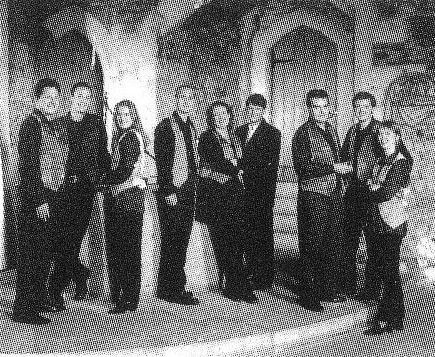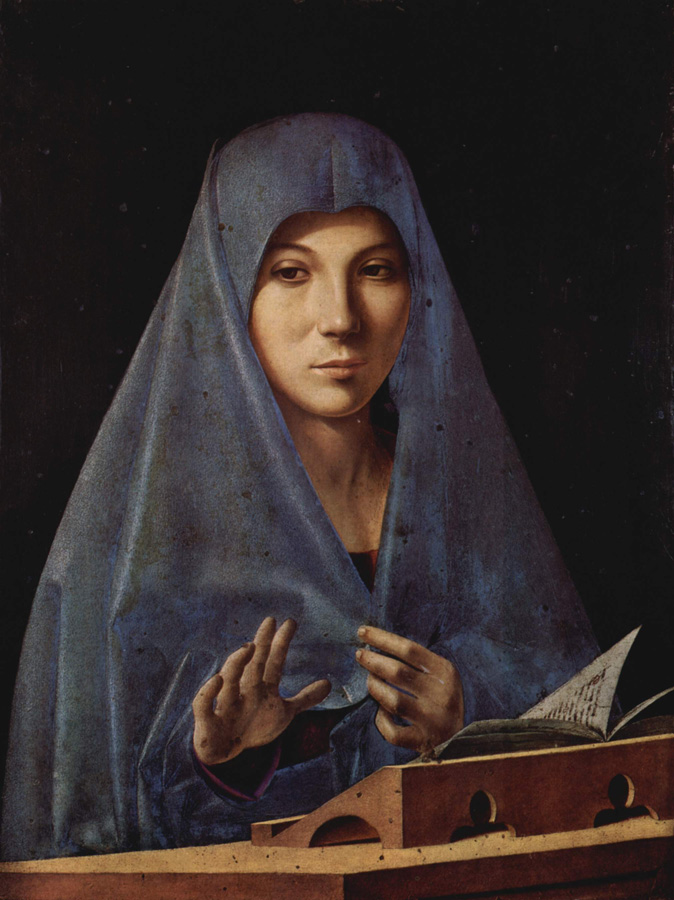
medieval.org
Signum Records SIGCD023
2002
1. Vasilissa, ergo gaude [2:46]
altos, tenor ChW, bass EW
2. Kyrie 'Fons bonitatis' [6:59]
tutti
3. O beate Sebastiane [2:59]
alto LB, tenors
4. Gloria · Bol. Q15 no. 107 [4:48]
altos, tenors
5. O gemma, lux et speculum [4:38]
altos, tenor MV, bass JA
6. Credo · Bol. Q15 no. 108 [6:30]
altos, tenors
7. Supremum est mortalibus bonum [6:26]
tutti
8. Sanctus and Benedictus · Bol. Q15 no. 104 [6:22]
tutti
9. Inclita stella maris [4:08]
altos, tenor ChW, bass JA
10. Agnus Dei · Bol. Q15 no. 105 [3:26]
tutti
11. Gloria 'Spiritus et alme' [6:04]
altos, tenors
12. O sancte Sebastiane [5:01]
altos, basses

The Clerks' Group
Edward Wickham
Alto: Lucy Ballard, William Missin
Tenor: Chris Watson, Matthew Vine
Bass: Edward Wickham, Jonathan Arnold
The Clerks' Group acknowledges with gratitude the help and advice
of Margaret Bent and Leofranc Holford-Strevens
Recorded in St Andrew's, West Wratting, August 31st to September 2nd 2000
by kind permission of the P.C.C.
Production, Engineering and Editing by Floating Earth
Producer: David Trendell Engineer: Limo Hearn
Editors: Raphaël Mouterde/Stephen Frost
Booklet notes: Edward Wickham
Text and translation editor: Christine Darby
Booklet design Sc typesetting: Jan Hart
Cover design: ATA Design
C 2002 The copyright of this CD booklet, notes, translations and visual design is owned by Sigum Records Ltd.
www.signumrecords.com

Guillaume Dufay. Sacred music from Bologna Q15
The manuscript Bologna, Civico Museo Bibliografico Musicale, MS Q15 is
one of the great anthologies of 15th century music, without which our
understanding of early Renaissance music would be hopelessly impaired.
It is known as Q15 to its friends; and it has many friends, for
contained within it are examples of almost every conceivable musical
genre of the period—with a special emphasis on sacred
polyphony—and works by a vast array of composers. And even if we
choose to make a selection of works by a single composer, as we have
done here, the variety of forms and styles on offer is bewildering.
This is partly because Q15 does not represent a snapshot of musical
taste at one moment in time and at one place. Compiled in three stages,
over a period of approximately fifteen years and in various parts of
northern Italy, Q15 underwent a number of major revisions which reflect
changing attitudes and trends. Margaret Bent's dedicated scholarly
detective work on the manuscript has revealed how parts of the first
version of the manuscript were cut up and the paper re-used for the
second and third versions. By deciphering what the original manuscript
contained and comparing it to the final version, we can appreciate how,
in the space of fifteen years, musical sensibilities had altered. (See,
for example, Margaret Bent, ‘A contemporary perception of early
fifteenth-century style’ in Musica Disciplina 41 (1987)).
In our choice of works from Q15 by Guillaume Dufay, we hope to reflect
the diversity of genre contained within the manuscript as well as
presenting some of the earlier works—often neglected—of a
composer who witnessed and contributed to most of the revolutionary
changes to occur in music composition in the 15th century. On his
deathbed, Dufay was apparently comforted by the strains of his motet Ave
regina coelorum, but his earliest datable work—also labelled
a motet—is in an entirely different style, to the extent that one
might hardly recognise it as the work of the same composer. Vasilissa,
ergo gaude was written to celebrate the nuptials of Princess
Cleofe—part of the Malatesta clan for whom Dufay worked—and
Theodore Palaiologos II, the son of the Emperor of Constantinople. The
year was 1420 and while the rulers of Eastern Christianity were
desperately trying to shore up support from their Western
co-religionists against the Ottoman threat, the Western church was
involved in a council at Constance which aimed to resolve the
long-standing schism in Roman Catholicism. By the time of Dufay's
death, that schism would be resolved, but Constantinople would be in
the hands of the infidel.
Vasilissa inhabits a different musical world as well. Composed
in an isorhythmic format in which the rhythms of the second half of the
motet exactly repeat those in the first half, the motet celebrates the
techniques of the previous century as well as revealing a reverence for
another Northern European composer working in Italy, Johannes Ciconia.
The other three isorhythmic motets in this programme—O gemma,
lux et speculum, Supremum est mortalibus bonum and O
sancte Sebastiane—display varying degrees of enthusiasm for
the technique, but what is so impressive about Dufay's handling of
these predetermined structures is his ability to balance the
requirements of the form with the impulse to compose lyrical,
free-flowing tunes. Naive as it may sound in a discussion of
sophisticated sacred polyphony, Dufay is ever the supreme
melody-monger. His melodies may not always be held by a single voice:
in the four-voice works the top voices often playfully exchange roles,
one holding a coherent line while the other dances around it,
frequently decorating and ornamenting the material. But in all his
vocal polyphony there is a song-like quality to the writing which is
entirely distinctive and beguiling.
What has already been said should not encourage the view that Dufay
unquestioningly adopts the forms that he is given. Supremum est
mortalibus bonum, composed to commemorate the signing of a peace
treaty in 1433 between Pope Eugenius IV and King Sigismund (soon to be
Holy Roman Emperor), is a wonderfully eclectic creation, combining
isorhythm (in the tenor voice only) with solemn fauxbourdon and
declamatory homophony. In other works which are categorised as
‘motets’, Dufay abandons the isorhythrnic principle
altogether. O beate Sebastiane is written in a free form, with
a decorative upper voice accompanied by two lower voices with
supporting roles. Inclita stella maris is a particular
curiosity. The upper voices form a mensural canon: they sing the same
melody but at slightly different speeds. Again, the lower voices in
this work are unimportant and, according to the rubrics of the piece,
one of them can even be abandoned without impairment.
In fact, this is not uncommon amongst the works contained in Q15 and
other contemporary manuscripts. Extra contratenor parts were often
added or taken away from three and four part works, presumably
according to the taste and resources of the performers. Margaret Bent's
work on Q15 has revealed how the scribe's preferences in terms of three
and four part works changed, and it is generally—though not
always—the case that later transmissions of works present works
in four part versions. The Gloria and Credo pair included in this
programme are likely to be examples of three voice originals which have
had a fourth voice added, not always successfully. We cannot assume,
however, that the fourth voice was not also by Dufay and, in the
absence of any contrary evidence, we have recorded the four-voice
versions. These are lively settings, linked by some eccentric harmonic
twists in the opening ‘head motifs’ of each movement. As
with the Sanctus and Agnus movements, these mass movement settings
pre-date the time when the mass ordinary was routinely composed as a
cycle of linked movements, composers preferring to pair Gloria with
Credo, and Sanctus with Agnus Dei. Unrelated to other polyphonic
settings, the Kyrie Fons bonitatis is instead affiliated to the
chant now known in the Liber Usualis as Kyrie II. In our
performance we have interspersed this chant with the polyphony to
create a traditional nine-fold structure for the movement.
Notes on Performance
and Editions
The performing editions used in this recording take as a starting point
the musical and literary texts as transcribed and edited by Heinrich
Besseler in the Corpus Mensurabilis Musicae series. On
occasions these versions have been changed after consultation with
facsimiles of the manuscript Bologna Q15, while text underlay and
musica ficta have been substantially altered during the rehearsal
process. In particular, lower voices have been texted where possible
and appropriate, Inclita stela maris being the only work in
which the lower parts are entirely vocalised. We have thus rendered in
sound the speculative comments of David Fallows about this work in his
important study Dufay (London, 1982, p. 132).
I regret that the article by Leofranc Holford-Strevens on Dufay's
literary texts (in Early Music History, xvi—1997) did not
come to my attention until after the recording had been made. This
article suggests emendations to the texts of the motets which, though
having no substantial impact upon the aural experience of these works,
ought nevertheless to be incorporated in future editions and recordings
of these works. It is hoped that those who use CD booklets as part of
their research into these works will take note and not perpetuate these
mistakes in the future.
In line with the suggestions of Charles W. Fox and, more recently,
Timothy J. McGee (The Sound of Medieval Song, Oxford, 1998) we
have interpreted the signs which in modern notation indicate pauses, as
indications of the opportunity for ‘cantus coronatus’, or a
form of improvised decoration. This ornamentation is somewhat
experimental, but was influenced in part by the kind of ornamentation
which is to be found in Italian vocal music of the early Baroque and
which was presumably influenced by earlier Renaissance practice.
Edward Wickham, July 2001
